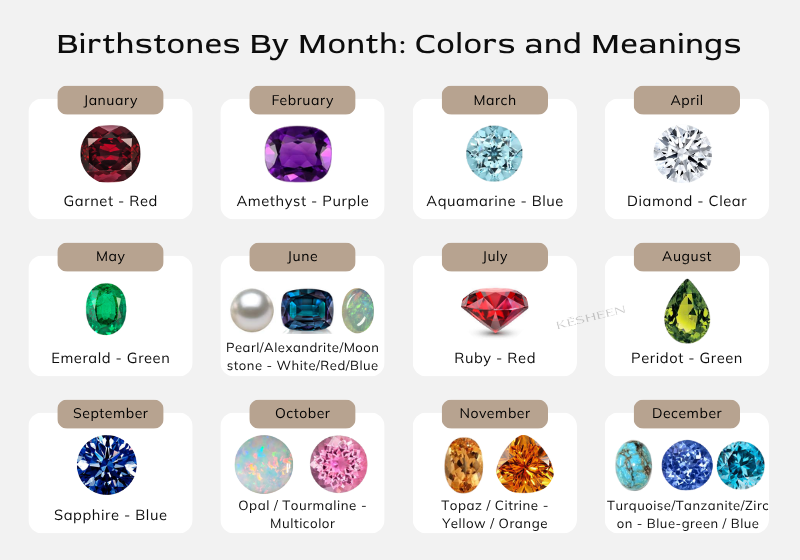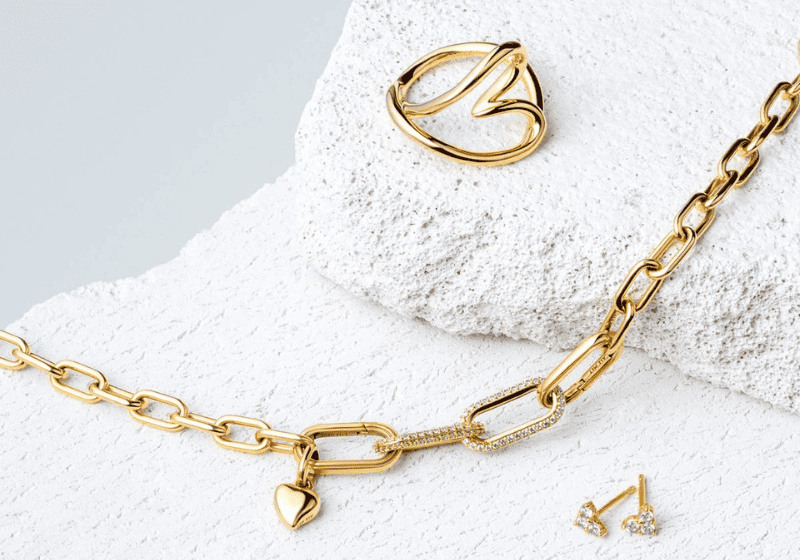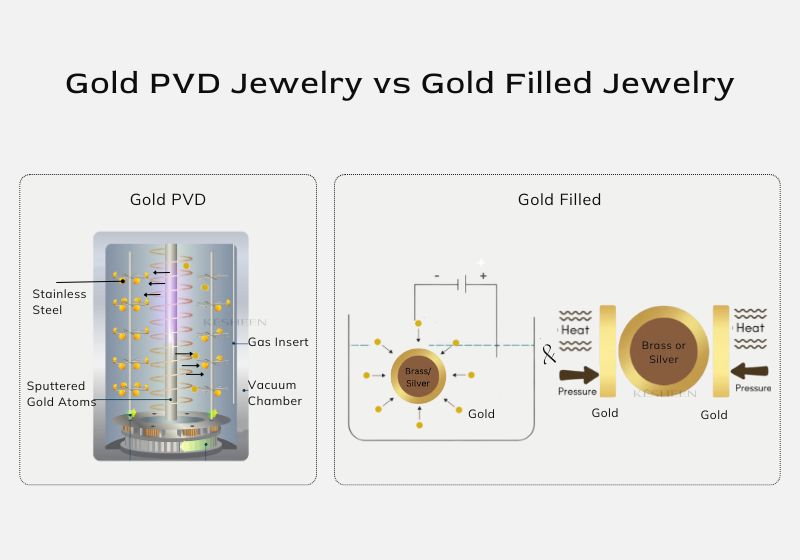Every jewelry brand begins with a dream—of beauty, meaning, and connection. But turning that dream into a business means making tough choices. One of the first, and most important, is deciding jewelry brand positioning, that is, how the world will see you: as a luxury icon, an affordable trendsetter, or something in between.
This guide isn’t just about strategy—it’s about helping you find a path that feels right for your vision, your customers, and the brand you’re building from the heart.
Key Differences Between Luxury and Affordable Jewelry Brands
Understanding the core differences between luxury and affordable jewelry positions is essential for effective jewelry branding when you start your jewelry business. Each approach targets distinct markets, materials, and messaging, influencing your jewelry brand pricing strategy.
Luxury Jewelry Brands:
- Use high-end materials like solid gold, 18k gold filled, diamonds, or rare gemstones.
- Focus on craftsmanship, exclusivity, and timeless appeal.
- Offer curated collections and build strong brand narratives.
Affordable Jewelry Brands:
- Use silver, stainless steel, brass, PVD gold plated jewelry, CZ to control costs.
- Appeal to trend-conscious buyers with accessible pricing.
- Launch new pieces frequently to stay relevant in fast-changing fashion trends.
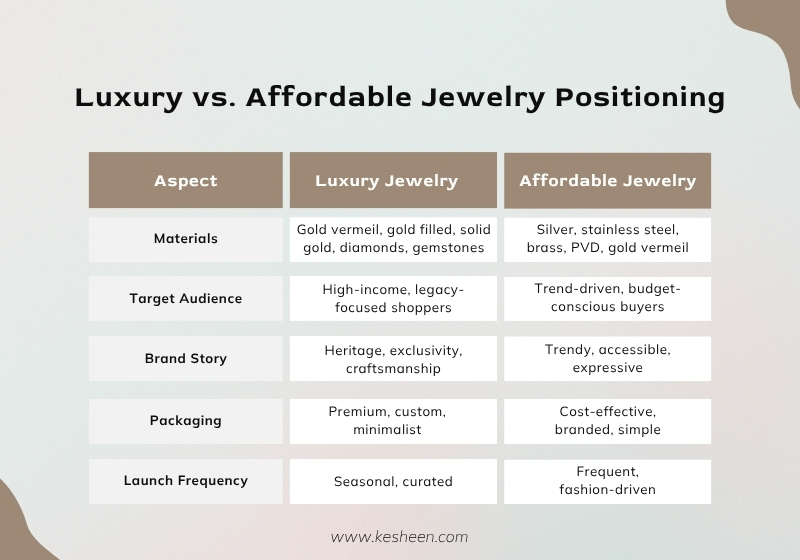
What Influences Your Brand Positioning Decision?
Your jewelry brand positioning hinges on several factors. Aligning these with your vision ensures a cohesive brand position that resonates with customers.
Target Audience and Their Values
Your customer profile is the foundation of your brand strategy. Ask yourself:
- Age: Are you targeting Gen Z (16–25), who love trends and bold self-expression, or Millennials (26–40), who often seek pieces with meaning and practicality?
- Gender: Are your designs unisex, feminine, or masculine in focus?
- Income level: Are your customers students on a budget, working professionals, or luxury spenders?
- Lifestyle & values: Do they care about sustainability, exclusivity, self-expression, or cultural identity?
Studying customer behavior isn’t optional—it’s essential. The more deeply you understand your audience, the more clearly your brand will speak to them.
Production Capabilities
If you’re a small business, consider what’s scalable. Can your jewelry manufacturer handle bespoke orders, or do you need fast turnaround and mass production? Material choice and production costs should align with your desired jewelry pricing.
Competition and Market Saturation
Analyze competitors in your niche. Luxury markets are less crowded but harder to enter, while affordable markets are competitive but offer broader reach. Researching jewelry niche examples helps identify gaps.
Long-Term Brand Vision and Goals
Where do you see your brand in 5 years? Some founders aim for long-term legacy, while others seek quick sales volume. Your jewelry brand pricing strategy should match your growth plan.
At Kesheen, we’ve worked with founders at every stage—some who knew exactly what they wanted, and others who were still exploring. And that’s okay. It’s a journey of discovery. The key is to stay honest with yourself about what matters most: your customers, your values, and your voice.
Luxury vs. Affordable: Strategic Pros and Cons
| Aspect | Luxury | Affordable |
| Profit Per Sale | High margins, fewer orders | Lower margins, high volume |
| Marketing Style | Story-driven, aspirational | Trendy, fast-paced |
| Entry Barrier | High (cost of materials, branding) | Low to mid (materials, faster go-to-market) |
| Brand Loyalty | Strong but requires continuous value | Variable; relies on price and style |
Exploring the “Affordable Luxury” Segment – For Startup Brands with Limited Budget
Many startups successfully position themselves as affordable luxury jewelry brands, blending elegance and value. Brands like VITALY and IOAKU thrive here. This jewelry pricing strategy combines mid-tier pricing with premium touches:
- Materials: Stainless steel with PVD gold plating for a luxe look.
- Messaging: Sustainability and elegant packaging.
- Audience: Design-savvy shoppers wanting quality without luxury markups.
Ideal for startups, this segment balances jewelry branding ideas like storytelling with scalable production.
Hybrid Strategies: Bridging the Gap
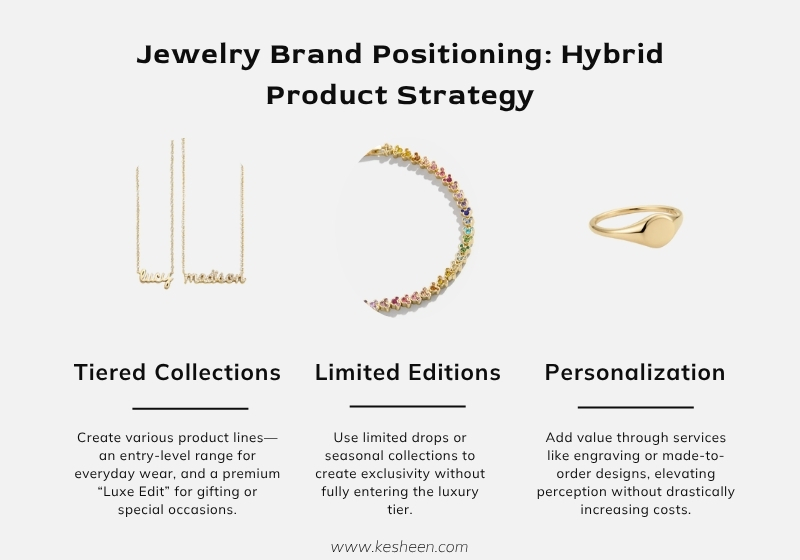
Hybrid strategies let you dream big while staying true to your roots, offering flexibility in jewelry brand positioning to connect with diverse customers.
- Tiered Collections
Create different product lines—an entry-level range for everyday wear, and a premium “Luxe Edit” for gifting or special occasions.
Example: Monica Vinader’s stackable bracelets vs. their diamond necklaces.
- Limited Editions
Use limited drops or seasonal collections with elevated packaging to create exclusivity without fully entering the luxury tier.
Example: Pandora’s limited-edition holiday charms, often featuring Swarovski crystals and exclusive designs, create buzz and attract customers seeking special pieces at accessible prices.
- Personalization
Add value through services like engraving or made-to-order designs—these elevate perception without drastically increasing costs.
Example: Mejuri offers engravable signet rings and custom charm necklaces, allowing customers to personalize affordable pieces, enhancing the luxury feel while keeping prices approachable.
By mixing premium touches with accessible pricing, jewelry brands can attract wider audiences while maintaining a strong brand identity.
Every Small Thing Should Align With Your Brand Positioning
Once you pick your jewelry brand positioning, keep it consistent across all channels.
- Website and Packaging Design
Luxury brands favor minimal, elegant design with high-end packaging. Affordable brands can still impress with creative, budget-conscious packaging.
- Social Media and Advertising Voice
Luxury brands use sophisticated, aspirational tones. Affordable brands adopt relatable, fun voices. Explore marketing materials & strategies to refine your approach.
- Photography and Logo
Visual branding matters. Whether you’re designing premium or budget jewelry, your look and feel must match. Partner with a custom jewelry manufacturer like Kesheen to manage your jewelry projects seamlessly, from concept to collection.
You Don’t Have to Use Precious Metal to Stand Out
Many new jewelry founders think, “I want to offer better quality—so I need to use gold or silver.” But that’s a misconception. Almost any material can feel premium with the right approach.
Brands like Vitaly, Kendra Scott, and Melinda Maria built loyal followings using stainless steel or brass. Their success proves that great design, smart branding, and strong storytelling matter more than the material itself.
In today’s market, the perception of value often comes from branding, storytelling, and customer experience. If your jewelry tells a compelling story, is beautifully presented, and meets your customers’ emotional needs, it will stand out—regardless of the metal used.
The takeaway? You don’t need gold to go premium. You need strategy.
Case Studies: Jewelry Brand Positioning Examples In Each Segment
Real stories inspire real decisions. Here are two brand positioning examples to light your path.
- Example of a Luxury Jewelry Brand and Their Strategy
Cartier uses heritage storytelling, premium materials, and exclusive launches to maintain its luxury brand position. Their focus on craftsmanship and limited collections drives demand.
- Example of an Affordable Jewelry Brand and Their Strategy
Vitaly harnesses social media and regular releases of bold, PVD gold plated jewelry to captivate millennials and Gen Z. Their jewelry branding emphasizes edgy, gender-neutral designs crafted from 100% recycled stainless steel, blending sustainability with urban style.
Choose the Path That Aligns With Your Vision
Your jewelry brand positioning affects your pricing, audience, and long-term success. Whether you go luxury, affordable, or affordable luxury, the key is alignment between your brand promise and what you deliver. Choose a path that suits your resources, customers, and goals.
FAQs
Start by identifying your audience and resources. If you’re targeting high-end buyers and can afford premium materials, go luxury. Otherwise, affordable jewelry branding offers quicker scalability.
Silver, stainless steel, brass, and PVD gold plated jewelry offer durability and style at a lower cost.
Yes, but rebranding takes time and effort. It’s easier to build a brand with a clear position from the start based on your long-term vision.

